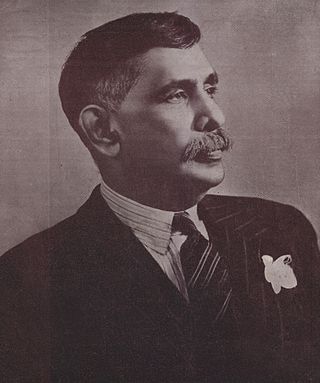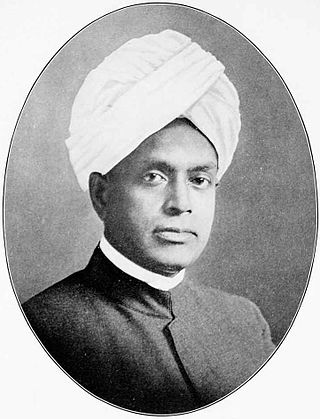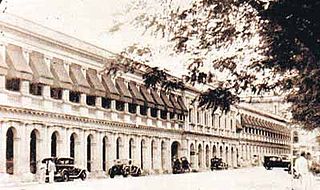| ||
The second election to the Legislative Council of Ceylon was held 20 January 1917. [1] [2]
| ||
The second election to the Legislative Council of Ceylon was held 20 January 1917. [1] [2]
In 1833 the Colebrooke-Cameron Commission created the Legislative Council of Ceylon, the first step in representative government in British Ceylon. Initially the Legislative Council consisted of 16 members: the British Governor, the five appointed members of the Executive Council of Ceylon, four other government officials and six appointed unofficial members (three Europeans, one Sinhalese, one Tamil and one Burgher).
In 1889 the number of appointed unofficial members was increased to eight (three Europeans, one Low Country Sinhalese, one Kandyan Sinhalese, one Tamil, one Muslim and one Burgher). [3]
The Legislative Council was reformed in 1910 by the McCallum Reforms. Membership was increased to 21 of which 11 were officially appointed and 10 were unofficial (two elected Europeans, one elected Burgher, one elected educated Ceylonese, two appointed Low Country Sinhalese, two appointed Tamils, one appointed Kandyan Sinhalese and one appointed Muslim). [4] Less than 3,000 Ceylonese were eligible to vote for the four elected unofficial members. [4]
The following were the elected unofficial members :

The history of Sri Lanka is unique because its relevance and richness extend beyond the areas of South Asia, Southeast Asia and the Indian Ocean. The early human remains which were found on the island of Sri Lanka date back to about 38,000 years ago.

Don Stephen Senanayake was a Ceylonese statesman. He was the first Prime Minister of Ceylon having emerged as the leader of the Sri Lankan independence movement that led to the establishment of self-rule in Ceylon. He is considered as the "Father of the Nation".

The Kandyan Wars refers generally to the period of warfare between the British colonial forces and the Kingdom of Kandy, on the island of what is now Sri Lanka, between 1796 and 1818. More specifically it is used to describe the expeditionary campaigns of the British Army in the Kingdom of Kandy in 1803 and 1815.
Burgher people, also known simply as Burghers, are a small Eurasian ethnic group in Sri Lanka descended from Portuguese, Dutch, British and other Europeans who settled in Ceylon. The Portuguese and Dutch had held some of the maritime provinces of the island for centuries before the advent of the British Empire. With the establishment of Ceylon as a crown colony at the end of the 18th century, most of those who retained close ties with the Netherlands departed. However, a significant community of Burghers remained and largely adopted the English language. During British rule, they occupied a highly important place in Sri Lankan social and economic life.

The Ceylon Workers' Congress (CWC) is a political party in Sri Lanka that has traditionally represented Sri Lankan Tamils of Indian origin working in the plantation sector of the economy.

Indian Tamils of Sri Lanka are Tamil people of Indian origin in Sri Lanka. They are also known as Malayaga Tamilar, Hill Country Tamils, Up-Country Tamils or simply Indian Tamils. They predominantly descend from workers sent from Southern India to Sri Lanka in the 19th and 20th centuries to work in coffee, tea and rubber plantations. Some also migrated on their own as merchants and as other service providers. These Tamil speakers mostly live in the central highlands, also known as the Malayakam or Hill Country, yet others are also found in major urban areas and in the Northern Province. Although they are all termed as Tamils today, some have Telugu and Malayalee origins as well as diverse South Indian caste origins. They are instrumental in the plantation sector economy of Sri Lanka. In general, socio-economically their standard of living is below that of the national average and they are described as one of the poorest and most neglected groups in Sri Lanka. In 1964 a large percentage were repatriated to India, but left a considerable number as stateless people. By the 1990s most of these had been given Sri Lankan citizenship. Most are Hindus with a minority of Christians and Muslims amongst them. There are also a small minority followers of Buddhism among them. Politically they are supportive of trade union-based political parties that have supported most of the ruling coalitions since the 1980s.
The origins of the Sri Lankan Civil War lie in the continuous political rancor between the majority Sinhalese and the minority Sri Lankan Tamils. According to Jonathan Spencer, a social anthropologist from the School of Social and Political Studies of the University of Edinburgh, the war is an outcome of how modern ethnic identities have been made and re-made since the colonial period, with the political struggle between minority Tamils and the Sinhalese-dominant government accompanied by rhetorical wars over archeological sites and place name etymologies, and the political use of the national past.

Sir Ponnambalam Ramanathan, was a Ceylon lawyer and politician who served as Solicitor-General of Ceylon.
The Soulbury Commission, announced in 1944 was, like its predecessor, the Donoughmore Commission, a prime instrument of constitutional reform in British Ceylon. The immediate basis for the appointment of a commission for constitutional reforms was the 1944 draft constitution of the Board of Ministers, headed by D.S. Senanayake. This commission ushered in Dominion status and Independence to Sri Lanka in 1948. Its constitutional recommendations were largely those of the 1944 Board of Ministers' draft, a document reflecting the influence of Senanayake and his main advisor, Sir Ivor Jennings.

The House of Representatives was the lower chamber of the parliament of Ceylon established in 1947 by the Soulbury Constitution. The House was housed in the old State Council building in Galle Face Green, Colombo and met for the first time on 14 October 1947. The First Republican Constitution of Sri Lanka, adopted on 22 May 1972, replaced the House of Representatives with the unicameral National State Assembly.

Major Edward "Eddie" Alexander Nugawela, ED was a Ceylonese lawyer, soldier and politician. He was the first Cabinet Minister of Education in independent Sri Lanka (1947–1954), later Cabinet Minister of Health (1954–1956), a Member of Parliament and State Council.

The Legislative Council of Ceylon was the legislative body of Ceylon established in 1833, along with the Executive Council of Ceylon, on the recommendations of the Colebrooke-Cameron Commission. It was the first form of representative government in the island. The 1931 Donoughmore Constitution replaced the Legislative Council with the State Council of Ceylon.

The British Ceylon period is the history of Sri Lanka between 1815 and 1948. It follows the fall of the Kandyan Kingdom into the hands of the British Empire. It ended over 2300 years of Sinhalese monarchy rule on the island. The British rule on the island lasted until 1948 when the country regained independence following the Sri Lankan independence movement.
The fourth election to the Legislative Council of Ceylon was held in 1924.
The third election to the Legislative Council of Ceylon was held on 21 April 1921.
The Colebrooke–Cameron Commission was appointed in 1833 as a Royal Commission of Eastern Inquiry by the British Colonial Office to assess the administration of the island of Ceylon and to make recommendations for administrative, financial, economic, and judicial reform. According to Sir Charles Jeffries' book, Ceylon - The Path to Independence, "by the time the Commission got round to Ceylon, in 1829, most of the members had fallen by the wayside, and only one, Major Colebrooke was left."
The Sri Lankan diaspora are Sri Lankan emigrants and expatriates from Sri Lanka, and their descendants, that reside in a foreign country. They number a total estimated population of around 3 million.
The 1915 Sinhalese-Muslim riots was a widespread and prolonged ethnic riot in the island of Ceylon between Sinhalese Buddhists and the Ceylon Moors. The riots were eventually suppressed by the British colonial authorities.

Sri Lanka–United Kingdom relations, or British-Sri Lankan relations, are foreign relations between Sri Lanka and the United Kingdom.
Arthur Hamilton Ekneligoda Molamure was a Ceylonese legislator. He was a member of the Legislative Council of Ceylon and had served as a police magistrate. He was arrested by the British during the 1915 Sinhalese-Muslim riots. Molamure was elected to the Legislative Council in the 1924 Ceylonese Legislative Council election from the Ratnapura Revenue District. He died in office in 1929 and he was succeeded by his nephew George R. de Silva in his constituency in the State Council of Ceylon that followed.
{{cite web}}: CS1 maint: unfit URL (link)